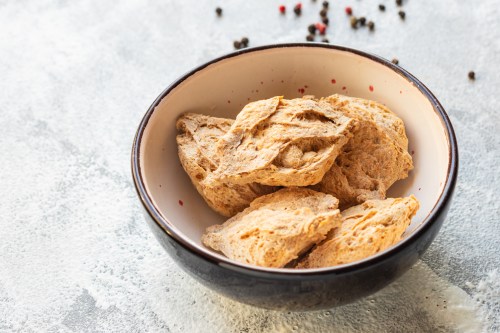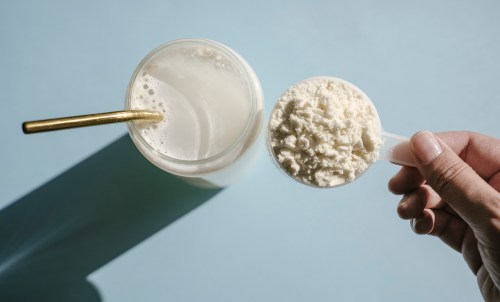Our editors independently select these products. Making a purchase through our links may earn Well+Good a commission
I’ve been vegan on and off for 10 years, and I still don’t really know what seitan is; I’ve eaten it a bunch, but have done so with a total lack of awareness around what it is that I’m putting in my mouth. Fortunately, there are people whose job it is to know such things, so I asked them not only what seitan is but how to make it at home, from scratch.
Experts in This Article
plant-based registered dietitian nutritionist and NASM-certified personal trainer
“Not to be confused with the demonic entity, seitan is a super-nutritious, plant-based protein,” says Whitney English Tabaie, RDN, author of The Plant-Based Baby and Toddler: Your Complete Feeding Guide for 6 months to 3 years. “Made from vital wheat gluten, seitan is rich in protein and low in carbohydrates and fat.” And while I’ve heard a lot of people complain about how processed vegan-friendly foods can be, seitan is not the product of some new technology. It’s been around for “as long as we know,” notes Chef Anne Thornton, founder of Áine Organics & The Plant Reset.
For centuries, people have typically utilized seitan as a meat substitute because, as English says:”The texture and elasticity of gluten mimics that of animal protein.” It’s a particularly great stand-in for chicken. Because of that aforementioned gluten, however, English points out that it’s not safe for people with Celiac disease or a wheat allergy. “But most people can enjoy it without any issues,” she says.
Below, English shares her recipe for versatile, super simple-seitan, while Thornton shares a dinner recipe that puts the plant-based protein front and center.
Super Simple Seitan
Yields 4 4-ounce Servings
Ingredients
1 cup vital wheat gluten1/4 cup chickpea flour (can sub regular flour)2–3 tsp herbs and spices of choice1 cup warm water2 liters vegetable stock1/4 cup soy sauce or tamari
1. In a medium-sized bowl, combine vital wheat gluten, flour, herbs, and spices of choice.
2. Add warm water, mix, and form into a ball.
3. Cover bowl with a clean kitchen towel and allow to sit out on the counter for about 20 minutes.
4. In a large pot, bring stock and soy sauce or tamari to a boil.
5. Add dough and reduce heat to a simmer.
6. Cover with a lid that is partially askew, allowing for steam to escape, and simmer for about an hour.
7. Remove dough from heat and allow to cool.
8. Slice it into strips, and enjoy! Seitan will last for about a week in the fridge or can be sliced and frozen for about three months.
Seitan “Chicken” Scallopini
Scallopini is an Italian terms for thinly sliced meat. Translation? You can treat this seitan the same way you would chicken breasts. “It can be roasted or grilled and thrown in a salad,” says Thornton. “It can be shredded and used in tacos or in BBQ sandwiches, fried like chicken and used in a sandwich, or it can be stir fried with a ton of veggies.”
Yields 6 Servings
Ingredients 1 ½ cups vital wheat gluten, plus more for dusting1 ¼ cups silken or soft tofu, 300g package2 Tbsp water2 Tbsp nutritional yeast2 1/2 tsp bouillon powder or 1 vegetable bouillon cube1 tsp garlic powder1 tsp onion powder¼ tsp sage powder½ tsp salt
1. Mix everything together in a large bowl until it forms a ball. If you have food processor, mix all of the ingredients and pulse to combine until everything is well-mixed, and the dough forms a ball.
2. Lightly dust a clean flat surface with a bit of the vital wheat gluten. Transfer the dough ball onto the surface and lightly dust the top with a little more vital wheat gluten. The dough will be soft and super sticky (this is what makes it taste “meaty”), and the extra flour will help keep the dough from sticking to your hands and making your life miserable. Rather than knead the dough like you would for bread, “work it” by slapping it onto the surface, stretching it, and folding it over itself. This develops the structure of the gluten, which makes it chewy and meat-like.
3. Cut the dough ball in half, and then cut each half into thirds to make six pieces. Shape each piece of dough into a flat oval, like a flat chicken breast.
4. Add a few inches of water to a large pot with a steamer basket and bring to a simmer. Brush the steamer basket with melted coconut oil or spray with oil, and then lay the tenders in the basket. If the tenders need to overlap each other, brush or spray the “chicken” scallopini with a bit of oil as this will help keep them from sticking together. (They will double in size, so take that into account when you are spacing them out.)
5. Cover and steam at a simmer for 25 minutes, making sure to flip them halfway through so that they cook evenly. You want to keep it at a gentle simmer the whole time, so you get the best texture.
6. Once steamed, remove the seitan “chicken” scallopini and let cool. Cover or put in an airtight container and chill in the fridge for a minimum of one hour, or for up to three to four days. This allows the glutenous protein to shrink up and taste meatier.
Seitan “Chicken” Piccata
Piccata is an Italian word for meat that’s pounded flat, lightly breaded, and tossed in sauce, then served over a starch like potatoes or pasta.
Yields 6 Servings
Ingredients Seitan “Chicken” Scallopini, one recipeSaltPepperAll-purpose flour6 Tbsp vegan butter5 Tbsp extra virgin olive oil2 Tbsp shallot or white onion, small dice1 Tbsp garlic, grated1/3 cup fresh lemon juice1/2 cup vegetable broth1/4 cup capers1/4 cup fresh parsley, chopped1/2 tsp red chili flakes2 Tbsp toasted pine nuts
1. Season the seitan chicken with salt and pepper then dredge (which means to coat it) in all-purpose flour. Repeat until all of the pieces have been dredged.
2. In a large skillet melt two tablespoons of butter and three tablespoons of the olive oil. When the fat starts to sizzle, go ahead and add three of the seasoned pieces of seitan, leaving a little space between each, and allow to cook for two to three minutes on each side, until golden brown. Transfer to a dish.
3. Add two more tablespoons of olive oil and two more tablespoons of vegan butter and cook the remaining seitan pieces.
4. Place the seitan pieces in an oven-safe dish, and hold in the oven at 250F.
5. In the same pan you cooked the seitan in, add the shallots, capers, lemons, broth, and garlic, reintroduce heat and bring to a boil, scraping all the good golden bits off of the bottom of the pan. Check the seasoning and add more salt, pepper, or lemon as desired.
6. Remove the seitan from the oven, plate it, and pour the sauce on top of it. Finish with the fresh parsley, chili flakes, and toasted pine nuts. Serve with mashed potatoes or pasta and broccolini.
Sign Up for Our Daily Newsletter
Get all the latest in wellness, trends, food, fitness, beauty, and more delivered right to your inbox.
Got it, you've been added to our email list.











